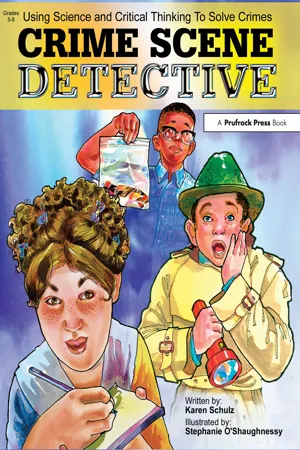
Crime Scene Detective
Using Science and Critical Thinking to Solve Crimes (Grades 5-8)
Karen K. Schulz
- 82 pages
- English
- ePUB (adapté aux mobiles)
- Disponible sur iOS et Android
Crime Scene Detective
Using Science and Critical Thinking to Solve Crimes (Grades 5-8)
Karen K. Schulz
À propos de ce livre
Watch the excitement ripple through your classroom as students use their intellect to find out who committed the "crime" at your school. Enliven your students as they practice critical thinking skills. Students are often taught skills such as the scientific method, scientific research, critical thinking, making observations, analyzing facts, and drawing conclusions in isolation. Studying forensic science allows students to practice these skills and see theories put into practice by using circumstances that model real-life events, meanwhile letting students explore a variety of career options.This exciting unit includes:
- background information on forensics,
- exploration of careers in forensic science and law enforcement,
- a simulation involving a fire in the school library, and
- instructions for writing your own crime scene simulation.
To crack the case, students examine evidence left at the scene, interview suspects (staff members), and use critical thinking to connect all of the clues and eliminate suspects. Students will feel like real investigators with this true-to-life simulation.Let your students solve more mysteries with Mystery Disease, Mystery Science, Detective Club, and The Great Chocolate Caper.Grades 5-8
Foire aux questions
Informations
Crime Scene Simulation
The Case of the Blazing Books
Overview
Roles
Motive
- vanity - wanting to be the hero, save people, get public recognition
- crime concealment - hiding a theft or other crime
- juvenile - kids under the age of 16 setting a fire for kicks
- insurance fraud - for financial gain; often the case in a failing business
- pyromaniac - a person who enjoys setting fires
- civil disorder - burning down a church, government office, or abortion clinic
- revenge - burning down someone's house or business to get revenge
Keeping the Secret
Recruiting Participants
Prepare Materials
- the newspaper article - page 28
- witness role description - page 29
- witness information (this is different for each person)
- the newspaper article - page 28
- the suspect role description - page 30
- the suspect profile (this is different for each person)
- request for evidence samples - pages 31, 32, 33
Gather Evidence
- Ask each suspect to complete an identification card (page 33). You may choose to just assign a blood type to each suspect. Take a picture with a digital camera and include it on the card. This identification will be kept on file in the fingerprint lab.
- Ask for a hair sample and tape it to a note card.
- Ask for each person to bring in a right-foot shoe. Photograph the bottom of the shoe, placing a ruler in the picture to determine an accurate scale. Print the picture and label it with the name of the person to whom it belongs. You will be leaving prints behind at the scene for the guilty person, so make sure you "stamp" the shoe of the guilty person before returning it. (See Setting Up the Scene, page 23-24.)
- Get a handwriting sample from each suspect for a note that is found at the scene. Use page 32. For the guilty person, have her write the grocery list on a plain piece of paper as well as on a copy of page 32. On the plain paper, she should only write the grocery items, not her name.
- You will need to get two samples of prints, hair and handwriting from the guilty party. One set will be left at the crime scene while the second set will be placed in the lab.